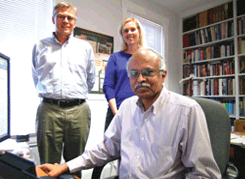Scholars, editors, and designers gathered once again on a recent spring day in Columbia University’s Butler Library building to brainstorm about transforming traditional texts into innovative e-books. This was the third in a series of workshops for winners of the Gutenberg-e Prize, organized by Columbia University Press with a grant from the Andrew W. Mellon Foundation. The latest workshop, held March 11 and 12, brought together two winners of the 1999 prize (who have already acquired considerable knowledge of the arcana of e-publishing) and the six winners of the 2000 Gutenberg-e Prizes, thus enabling the latter to benefit from the experience of the former. Also on hand to provide guidance were the editors and designers of Columbia University Press who have been working on the first set of six books, which will be launched at a special ceremony at the 2002 annual meeting of the AHA in San Francisco.
The first day of the workshop was essentially devoted to a discussion of the works in progress of the first set of Gutenberg-e prizewinners. On the second day, following the welcoming remarks from Kate Wittenberg, director of the electronic publishing initiative at the Columbia University Press, the second set of authors—who had received the 2000 Gutenberg-e prizes for their winning entries on the theme, “Europe before 1800″—made brief presentations about their dissertations and sketched out their tentative plans for the transformation of their manuscripts into e-texts.
Gregory Brown, discussing his dissertation, “A Field of Honor: Writers between Court Culture and Public Theater in the Age of Enlightenment (Columbia Univ., 1997), which focuses on the Comédie Française, said that he tried to explore how the playwrights fit into the trajectories of modernization and the emergence of civil society. Brown said that he was trying to understand—through a close reading of the playwrights’ correspondence—the writers’ place in French culture and the strategies of negotiation they developed to deal with the market place, the emerging institutions, and the nation.
Wayne Hanley’s dissertation, “The Genesis of Napoleonic Propaganda” (Univ. of Missouri at Columbia, 1998), took a novel approach to the emperor, looking at the actual mechanics of the image making that enabled Napoleon Bonaparte to rise from obscurity to fame in three years. Hanley pointed out that Napoleon used different media he had access to, not only publishing six newspapers dedicated to propaganda on his behalf, but also commissioning medallions and other works of art to keep his image in the public mind. The resulting popularity was further enhanced by the corollary production of other artifacts such as fans and cameos that streethawkers sold, capitalizing on Napoleon’s fame. Based as his dissertation was on a profusion of images, one of his problems, Hanley said, would be to decide which images he should include in his e-text and which he should exclude.
Sarah Lowengard‘s dissertation, “Color Practices, Color Theories, and the Creation of Color in Objects: Britain and France in the Eighteenth Century” (SUNY at Stonybrook, 1999), examined—in a comparative perspective—the relationship between science and art in terms of the use of color as a practice as well as a branch of optical theory. Telling the fascinating story of a piece of richly colored fabric sent from Leipzig to the 18th-century French court, Lowengard pointed out that even objects provided valuable information. She hopes, she said, that an e-book would enable her to use more color images, to explain the physical processes in greater detail, and to explain the history behind the process.
William MacLehose‘s dissertation, “‘A Tender Age’: Cultural Anxieties over the Child in the Twelfth and Thirteenth Centuries” (Johns Hopkins Univ., 1999), contested the traditional views about childhood in medieval Europe. MacLehose examined multiple discourses such as medical texts, bestiaries, debates on infant baptism and original sin, and legends to reconstruct the evolution of the notion of “child.”
Michael Smith, whose dissertation, “Anti-Radical Expression: Counter-revolutionary Thought in the Age of Revolution” (Univ. of California at Riverside, 1999) challenged existing notions about the development of antirevolutionary ideology in Britain at the end of the 18th century, wondered how scholars and readers would interact with the material that he expects to present as part of his e-text.
In her dissertation,”Like Wheat to the Miller: Community, Convivencia, and the Construction of Morisco Identity in Sixteenth-Century Aragon” (Univ. of California at San Diego, 1997), Mary Halavais exploredthe relations between communities and using a variety of documents, contested the traditional historiography on the subject. She said that she would like, as she revises her manuscript, to examine the Barcelona crown archives to further develop her arguments.
As Robert Darnton explained, the object of the Gutenberg-e Prize program is to help the transformation of a good dissertation into a better e-book. But if the e-books were to succeed as scholarship, it would be necessary to develop modes of criticism and review that would legitimate and authenticate the new publications, said Michael Grossberg, editor of the American Historical Review. Grossberg and his colleagues are trying to draw up guidelines, he said, for reviewing these new forms of scholarship—a difficult task, as there are no precedents. Will a reviewer be overwhelmed by the amount and variety of the material that is presented? Will technology allow the documentation to push the interpretation into the background? These were some of the questions with which the authors and publishers of e-texts had to contend.



